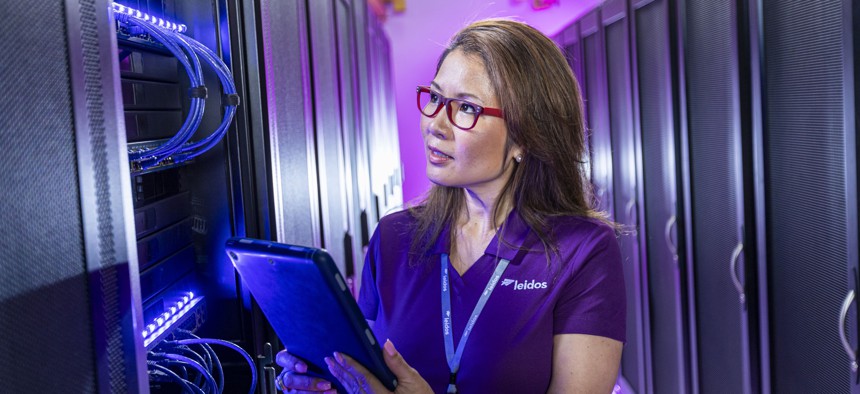sponsor content What's this?

Leidos succeeds in modernizing complex efforts for the IRS
While moving into the future of modernization, the IRS partners with Leidos to innovate and apply new technologies which inspire agile practices and confidence.
Presented by
Leidos

At Leidos we see the IRS commitment to putting taxpayers first—in executing their responsibility to collect revenue. While IRS sees more than its fair share of public criticism, it carries out its work through extensive planning, a drive to modernize, strong management and oversight, with a commitment to getting it right for every American taxpayer.
In 2020 especially, the agency had to demonstrate that commitment with flexibility while navigating the impacts of the COVID-19 pandemic. Issuing stimulus payments to Americans quickly and extending the filing season for taxpayers left IRS accommodating the disruption of critical internal business rhythms that are decades old.
Like many federal agencies, IRS has been able to leverage enabling technology and relationships with key industry partners to develop solutions to the year’s unique challenges. For example, working with Leidos, IRS created the popular “Get My Payment” application taxpayers have used to find and track their stimulus payments, and IRS has met this challenge three consecutive times in 2020 and 2021.
Incremental modernization
As with many federal agencies, the IRS has a complex systems environment with multiple generations of technologies that must communicate a myriad of data, statuses, responses, and outcomes. This environment makes modernization efforts complex requiring added funding requirements, careful planning, and specialized expertise.
The agency often leans on industry partners to modernize program systems wherever practical. Some actions are small and limited in impact while others are very consequential and build better capability.
Leidos understands that small, incremental actions can make a significant impact for Americans. One example is the upgrades to the tools tax preparers and other third parties use to do business with the IRS. Leidos began supporting a series of IRS modernizations that, over the ensuing decade, produced a robust, modernized suite of tools for public use. In 2008, a redesigned Transcript Delivery System (TDS) improved services and decreased costs and was followed by a small modernization of the Taxpayer Identification Number (TIN) match processes. A decade later in 2018, the IRS, working with Leidos, delivered the External Security Access Management (ESAM) system. This effort allowed IRS to jettison an expensive vendor-specific platform and align the system to IRS technology standards as it registers and checks the suitability of almost 900,000 registered third parties. The IRS has benefited from better data capture, fewer errors in registration, and an elegant architecture that allows new roles (applications) to be added far more quickly and at less cost.
In 2019, Leidos continued this modernization effort by adding an interface with the Federal Bureau of Investigation (FBI) to ensure registered users who violated laws or terms of their registration were identified—a check that allows taxpayers to choose a tax preparer with confidence. The first external facing Application Program Interfaces (APIs) were also developed in late 2019, and ease the process for tax preparers in obtaining needed data from IRS. This series of incremental modernizations is keeping pace with the commercial marketplace, and better serving taxpayers and tax practitioners.
IT best practices
Good architecture and design in information systems pays long-term dividends. The Leidos design for ESAM enables faster changes to the software in the future, reducing costs and serving taxpayers more efficiently. Paired with good IT practices, changes to systems are orderly and effective. For example, the IRS piloted DevOps with Leidos on a taxpayer facing application, which then evolved to CI/CD. Leidos has helped IRS propel adoption of Collaborative Lifecycle Management (CLM), the methodology that establishes and keeps strong requirements traceability. Working with companies like Leidos, the agency was enabled to triangulate rational tools for the strongest baseline control, and have improved configuration management controls. Setting up these processes correctly at the inception of new and modernized systems is essential to doing CI/CD well.
Agile, affordable software development
A very practical example of agile practices paying dividends, the IRS has been working with Leidos to upgrade the tools customer service personnel use to respond to taxpayers. Newer, more modern browsers are necessitating changes to their systems and tools and the IRS can now use agile practices to not only solve the browser compatibility issues that exist, but also make improvements users want to improve efficiency and response accuracy to taxpayers for the same cost.
And speed can matter. Collaborating with IRS, Leidos delivered the Get My Payment portal, allowing Americans to provide banking information and track much needed stimulus payments. Launched on April 15, 2020, it quickly and efficiently responded to more than 700 million user requests. Leidos used an application framework that uses predefined modules to more quickly produce applications for taxpayer use. This enabled the agency to establish the Get My Payment application in just a couple of weeks. By leveraging Leidos’ industry knowledge and cybersecurity strength, they closed the security hole in the commercial tools and added the value of the development framework. The agency can now produce applications faster, and for less cost, that directly help taxpayers.
Moving into the future of modernization for the IRS, further partnerships to address cybersecurity, data protection and analysis, process automation and artificial intelligence. The complexities of the IRS mission, and the amount of data collected and processed, will offer further opportunity for modernization, best practice implementation, agile software development, secure DevOps, and faster capability delivery. While it’s unlikely Americans will ever enjoy paying their taxes, how IRS innovates and applies new technologies should inspire confidence in the public that this work is in good hands.
This content is made possible by our sponsor, Leidos. The editorial staff was not involved in its preparation.
NEXT STORY: Behind the Transformation Efforts Changing the Federal Health Landscape






